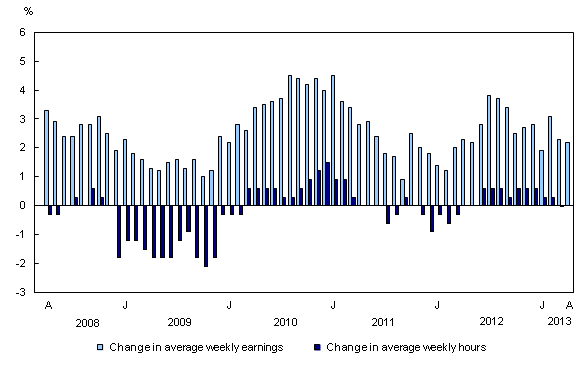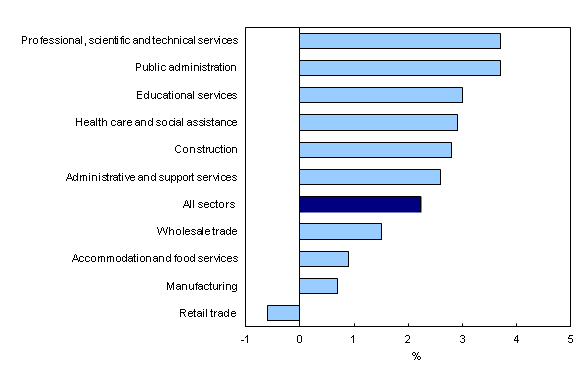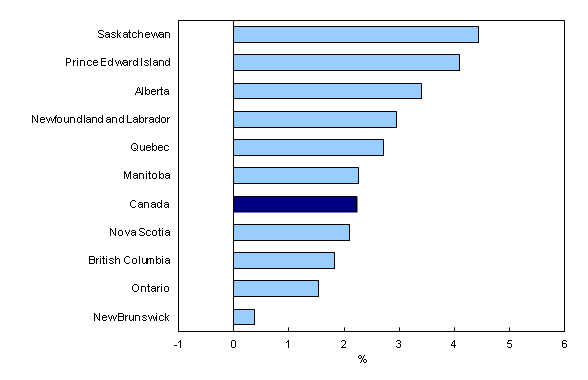Payroll employment, earnings and hours, April 2013
Archived Content
Information identified as archived is provided for reference, research or recordkeeping purposes. It is not subject to the Government of Canada Web Standards and has not been altered or updated since it was archived. Please "contact us" to request a format other than those available.
Released: 2013-06-27
Average weekly earnings of non-farm payroll employees rose 0.2% from the previous month to $910 in April. On a year-over-year basis, earnings increased 2.2%.
The 2.2% increase in earnings during the 12 months to April reflected a number of factors, including wage growth, changes in composition of employment by industry, occupation and level of job experience, as well as average hours worked per week. In April, non-farm payroll employees worked an average of 32.9 hours per week, unchanged from both the month and year before.
Average weekly earnings by sector
Year-over-year growth in average weekly earnings outpaced the national average in six of the largest industrial sectors, led by professional, scientific and technical services as well as public administration.
In professional, scientific and technical services, average weekly earnings rose by 3.7% to $1,291, led by growth in legal services; computer systems design and related services; and architectural, engineering and related services.
Compared with 12 months earlier, weekly earnings also rose by 3.7% to $1,163 in public administration, mainly a result of growth in local, municipal and regional public administration.
Average weekly earnings in educational services increased 3.0% to $1,010 in the 12 months to April, with notable growth in universities and community colleges and CEGEPs.
Weekly earnings in health care and social assistance increased 2.9% to $834, with the largest increases in social assistance and in hospitals.
In the 12 months to April, average earnings in construction rose 2.8% to $1,172, driven mostly by gains within heavy and civil engineering construction.
Compared with April 2012, weekly earnings in administrative and support services went up by 2.6% to $751, almost all a result of earnings gains within employment services.
Weekly earnings in retail trade edged down 0.6% to $524 in the 12 months to April, with the losses spread across a number of retail industries. Earnings in retail trade have been hovering around this level for a year, as small gains in hourly earnings have been offset by declines in average weekly hours.
Average weekly earnings by province
Year-over-year earnings growth of non-farm payroll employees was above the national average in six provinces, with the highest growth in Saskatchewan and Prince Edward Island. New Brunswick had the lowest earnings growth over this period.
Average weekly earnings in Saskatchewan increased by 4.4% to $944 in the 12 months to April, with the growth widespread across a number of industries.
In Prince Edward Island, year-over-year earnings growth was 4.1%, bringing average earnings to $758 in April. There was notable growth in professional, scientific and technical services; educational services; retail trade; and public administration.
Compared with April 2012, average weekly earnings in Alberta rose 3.4% to $1,098, with growth across most sectors.
Over the same period, earnings in New Brunswick edged up 0.4% to $808. Year-over-year growth in this province has been at or below the national average since September 2012.
Non-farm payroll employment by sector
Total non-farm payroll employment edged up by 5,500 in April after increasing by 29,800 in March.
In April, the number of payroll employees increased in accommodation and food services; educational services; and health care and social assistance. At the same time, there were fewer jobs in construction; arts, entertainment and recreation; retail and wholesale trade; and public administration.
On a year-over-year basis, the number of non-farm payroll employees rose by 194,900 or 1.3%.
Among all sectors, real estate and rental and leasing posted the highest 12-month growth rate in payroll employment at 5.6%, followed by construction (+4.8%), as well as accommodation and food services (+3.2%). Over the same period, there were also declines, primarily in information and cultural industries (-3.2%) and public administration (-1.1%).
Note to readers
The Survey of Employment, Payrolls and Hours (SEPH) is produced by a combination of a census of payroll deductions, provided by the Canada Revenue Agency, and the Business Payrolls Survey, which collects data from a sample of 15,000 establishments. Its key objective is to provide a monthly portrait of the level of earnings, the number of jobs and hours worked by detailed industry at the national, provincial and territorial level.
Estimates of average weekly earnings and hours are based on a sample and are therefore subject to sampling variability. Payroll employment estimates are based on a census of administrative data and are not subject to sampling variability.
Statistics Canada also produces employment estimates from its monthly Labour Force Survey (LFS). The LFS is a household survey, the main objective of which is to divide the working-age population into three mutually exclusive groups: the employed (including the self-employed), unemployed and not in the labour force. This survey is the official source for the unemployment rate and collects data on the socio-demographic characteristics of all those in the labour market.
As a result of conceptual and methodological differences, estimates of changes from SEPH and LFS do differ from time to time. However, the trends in the data are quite similar.
Unless otherwise stated, this release presents seasonally adjusted data, which facilitates comparisons by removing the effects of seasonal variations. For more information on seasonal adjustment, see Seasonal adjustment and identifying economic trends.
Non-farm payroll employment data are for all hourly and salaried employees, as well as the "other employees" category, which includes piece-rate and commission-only employees.
Average weekly hours data are for hourly and salaried employees only and exclude businesses that could not be classified to a North American Industry Classification System (NAICS) code.
All earnings data include overtime pay and exclude businesses that could not be classified to a NAICS code. Earnings data are based on gross taxable payroll before source deductions. Average weekly earnings are derived by dividing total weekly earnings by the number of employees.
With each release, data for the current reference month are subject to revision. Data have been revised for the previous month. Users are encouraged to request and use the most up-to-date data for each month.
A data table is available from the Browse by key resource module of our website under Summary tables.
Data on payroll employment, earnings and hours for May will be released on July 25.
Contact information
For more information, contact us (toll-free 1-800-263-1136; infostats@statcan.gc.ca).
To enquire about the concepts, methods or data quality of this release, contact Jason Gilmore (613-951-7118; jason.gilmore@statcan.gc.ca), Labour Statistics Division.
- Date modified:




